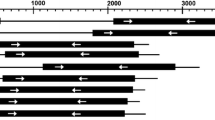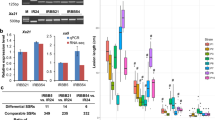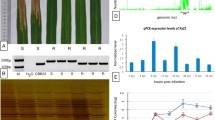Abstract
Bacterial blight and fungal blast diseases of rice, caused by Xanthomonas oryzae pv. oryzae and Pyricularia grisea Sacc., respectively, are two of the most devastating diseases in rice worldwide. To study the defense responses to infection with each of these pathogens, expression profiling of 12 defense-responsive genes was performed using near-isogenic rice lines that are resistant or susceptible to bacterial blight and fungal blast, respectively, and rice cultivars that are resistant or susceptible to both pathogens. All 12 genes showed constitutive expression, but expression levels increased in response to infection. Based on their expression patterns in 12 host-pathogen combinations, these genes could be classified into three types, pathogen non-specific (6), pathogen specific but race non-specific (4) and race specific (2). Most of the 12 genes were only responsive during incompatible interactions. These results suggest that bacterial blight and fungal blast resistances share common pathway(s), but are also regulated by different defense pathways in rice. Activation of the corresponding R gene is the key step that initiates the action of these genes in defense responses. The chromosomal locations and pathogen specificities of seven of the 12 genes were consistent with those of previously identified quantitative trait loci for rice disease resistance, which indicates that some of the 12 genes studied may have a phenotypic impact on disease resistance in rice.


Similar content being viewed by others
References
Albar L, Lorieux M, Ahmadi N, Rimbault I, Pinel A, Sy AA, Fargette D, Ghesquiere A (1998) Genetics basis and mapping of the resistance to rice yellow mottle virus. I. QTLs identification and relationship between resistance and plant morphology. Theor Appl Genet 97:1145–1154
Altschul SF, Madden TL, Schaffer AA, Zhang J, Zhang Z, Miller W, Lipman DJ (1997) Gapped BLAST and PSI-BLAST: a new generation of protein database search programs. Nucleic Acids Res 25:3389–3402
Austin MJ, Muskett P, Kahn K, Feys BJ, Jones JDG, Parker JE (2002) Regulatory role of SGT1in early R gene-mediated plant defenses. Science 295:2077–2080
Azevedo C, Sadanandom A, Kitagawa K, Freialdenhoven A, Shirasu K, Schulze-Lefert P (2002) The RAR1 interactor SGT1, an essential component of R gene-triggered disease resistance. Science 295:2073–2076
Chen H (2001) Population structure of Pyricularia grisea from Central and Southern China and comparative mapping of QTL for blast- and bacterial blight-resistance in rice and barley (in Chinese). PhD thesis. Huazhong Agriculture University, Wuhan, China
Chen HL, Chen BT, Zhang DP, Xie YF, Zhang Q (2001) Pathotypes of Pyricularia grisea in rice fields of Central and Southern China. Plant Dis 85:843–850
Chen H, Wang S, Xing Y, Xu C, Hayes PM, Zhang Q (2003) Comparative analyses of genomic locations and race specificities of loci for quantitative resistance to Pyricularia grisea in rice and barley. Proc Natl Acad Sci USA 100:2544–2549
Chern M-S, Fitzgerald HA, Yadav RC, Canlas PE, Dong X, Ronald PC (2001) Evidence for a disease-resistance pathway in rice similar to the NPR1-mediated signaling pathway in Arabidopsis. Plant J 27:101–113
Dong X (2001) Genetic dissection of systemic acquired resistance. Curr Opin Plant Biol 4:309–314
Etienne P, Petitot AS, Houot V, Blein JP, Suty L (2000) Induction of tcI 7, a gene encoding a beta-subunit of proteasome, in tobacco plants treated with elicitins, salicylic acid or hydrogen peroxide. FEBS Lett 466:213–218
Faris JD, Li WL, Liu DJ, Chen PD, Gill BS (1999) Candidate gene analysis of quantitative disease resistance in wheat. Theor Appl Genet 98:219–225
Glazebrook J (2001) Genes controlling expression of defense responses in Arabidopsis -2001 status. Curr Opin Plant Biol 4:301–308
Harushima Y, et al (1998) A high-density rice genetic linkage map with 2275 markers using a single F2 population. Genetics 148:479–494
Kauffman HE, Reddy APK, Hsieh SPY, Merca SD (1973) An improved technique for evaluating resistance of rice varieties to Xanthomonas oryzae. Plant Dis Rep 57:537–541
Li Z, Pinson SRM, Marchetti MA, Stansel JW, Park WD (1995) Characterization of quantitative trait loci (QTLs) in cultivated rice contributing to field resistance to sheath blight ( Rhizoctonia solani). Theor Appl Genet 91:382–388
Li Z-K, Luo LJ, Mei HW, Paterson AH, Zhao XH, Zhong DB, Wang YP, Yu XQ, Zhu L, Tabien R, Stansel JW, Ying CS (1999) A "defeated" rice resistance gene acts as a QTL against a virulent strain of Xanthomonas oryzae pv. oryzae. Mol Gen Genet 261:58–63
Lin XH, Zhang DP, Xie YF, Gao HP, Zhang Q (1996) Identifying and mapping a new gene for bacterial blight resistance in rice based on RFLP markers. Phytopathology 86:1156–1159
Lincoln S, Daly M, Lander E (1992) Constructing genetic maps with Mapmaker/Exp 3.0 (3rd edn). Whitehead Institute Technical Report, Whitehead Institute, Cambridge, Mass.
Mackill DJ, Bonman JM (1992) Inheritance of near-isogenic lines of rice. Phytopathology 82:746–749
Maleck K, Levine A, Eulgem T, Morgan A, Schmid J, Lawton KA, Dangl JL, Dietrich RA (2000) The transcriptome of Arabidopsis thaliana during systemic acquired resistance. Nature Genet 26:403–410
Ohme-Takagi M, Shinshi H (1995) Ethylene-inducible DNA binding proteins that interact with an ethylene-responsive element. Plant Cell 7:173–182
Reimmann C, Dudler R (1993) Circadian rhythmicity in the expression of a novel light-regulated rice gene. Plant Mol Biol 22:165–170
Roumen EC (1994) A strategy for accumulating genes for partial resistance to blast disease in rice within a conventional breeding program. In: Zeigler RS, Leong SA, Teng PS (eds) Rice blast disease. CAB International, Wallingford, UK, pp 245–265
Rushton PJ, Tovar TJ, Parniske M, Wernert P, Hahlbrock K, Somssich IE (1996) Interaction of elicitor-induced DNA-binding proteins with elicitor response elements in the promoter of parsley PR1genes. EMBO J 15:5690–5700
Schenk PM, Kazan K, Wilson I, Anderson JP, Richmond T, Somerville SC, Manners JM (2000) Coordinated plant defense responses in Arabidopsis revealed by microarray analysis. Proc Natl Acad Sci USA 97:11655–11660
Seehaus K, Tenhaken R (1998) Cloning of genes by mRNA differential display induced during the hypersensitive reaction of soybean after inoculation with Pseudomonas syringae pv. glycinea. Plant Mol Biol 38:1225–1234
Silverman P, Seskar M, Kanter D, Schweizer P, Metraux JP, Raskin I (1995) Salicylic acid in rice: biosynthesis, conjugation, and possible role. Plant Physiol 108:633–639
Staswick PE, Lehman CC (1999) Jasmonic acid-signaled responses in plants. In: Agrawal AA, Tuzun S, Bent E (eds) Induced plant defenses against pathogens and herbivores. APS Press, St. Paul, Minn., pp 117–136
Wang G-L, Mackill DJ, Bonman M, McCouch SR, Champoux MC, Nelson RJ (1994) RFLP mapping of genes conferring complete and partial resistance to blast in a durably resistant rice cultivar. Genetics 136:1421–1434
Wang J, Liu KD, Xu CG, Li XH, Zhang Q (1998) The high level of wide-compatibility of 'Dular' has a complex genetic basis. Theor Appl Genet 97:407–412
Wang S, Wang J, Jiang J, Zhang Q (2000) Mapping of centromeric regions on the molecular linkage map of rice ( Oryza sativa L.) using centromere-associated sequences. Mol Gen Genet 263:165–172
Wang Z, Yang P, Fan B, Chen Z (1998) An oligo selection procedure for identification of sequence-specific DNA-binding activities associated with the plant defense response. Plant J 16:515–522
Wang Z, Taramino G, Yang D, Liu G, Tingey SV, Miao G-H, Wang G-L (2001) Rice ESTs with disease-resistance gene- or defense-response gene-like sequences mapped to regions containing major resistance genes or QTLs. Mol Genet Genomics 265:302–310
Xing YZ, Tan YF, Hua JP, Sun XL, Xu CG, Zhang Q (2002) Characterization of the main effects, epistatic effects and their environmental interactions of QTLs in the genetic basis of yield traits in rice. Theor Appl Genet 105:248–257
Xiong L, Wang S, Liu K, Dai X, Saghai Maroof MA, Hu J, Zhang Q (1998) Distribution of simple sequence repeat and AFLP markers in molecular linkage map of rice. Acta Botanica Sinica 40:605–614
Xiong M, Wang S, Zhang Q (2002) Coincidence in map positions between pathogen-induced defense-responsive genes and quantitative resistance loci in rice. Science in China (Series C) 45:518–526
Yang P, Chen C, Wang Z, Fan B, Chen Z (1999) A pathogen- and salicylic acid-induced WRKY DNA-binding activity recognizes the elicitor response element of the tobacco class I chitinase gene promoter. Plant J 18:141–149
Yang Z, Sun X, Wang S, Zhang Q (2003) Genetic and physical mapping of a new gene for bacterial blight resistance in rice. Theor Appl Genet, in press
Yoshimura S, Yoshimura A, Saito A, Kishimoto N, Kawase M, Yano M, Nakagahara M, Ogawa T, Iwata N (1992) RFLP analysis of introgressed chromosomal segments in three near isogenic lines of rice for bacterial blight resistance genes, Xa-1, Xa-3, Xa-4. Jpn J Genet 67:29–37
Yoshimura S, Yamanouchi U, Katayose Y, Toki S, Wang Z X, Kono I, Kurata N, Yano M, Iwata N, Sasaki T (1998) Expression of Xa1, a bacterial blight-resistance gene in rice, is induced by bacterial inoculation. Proc Natl Acad Sci USA 95:1663–1668
Zhou B, Peng K, Chu Z, Wang S, Zhang Q (2002) The defense-responsive genes showing enhanced and repressed expression after pathogen infection in rice ( Oryza sativa L.). Science in China (Series C) 45:450–467
Acknowledgements
We sincerely thank the International Rice Research Institute for providing the disease-resistant near-isogenic lines, and the Philippine strains and isolates of Xoo and P. grisea,respectively. This research was supported by grants from the National Natural Science Foundation of China (39970450) and the National Key Program on Basic Research and Development of China (G2000016200)
Author information
Authors and Affiliations
Corresponding author
Additional information
Communicated by R. Hagemann
Rights and permissions
About this article
Cite this article
Wen, N., Chu, Z. & Wang, S. Three types of defense-responsive genes are involved in resistance to bacterial blight and fungal blast diseases in rice. Mol Gen Genomics 269, 331–339 (2003). https://doi.org/10.1007/s00438-003-0839-x
Received:
Accepted:
Published:
Issue Date:
DOI: https://doi.org/10.1007/s00438-003-0839-x




